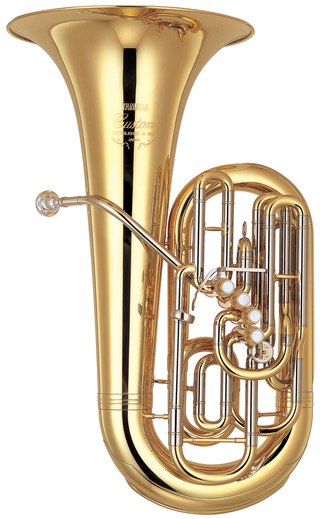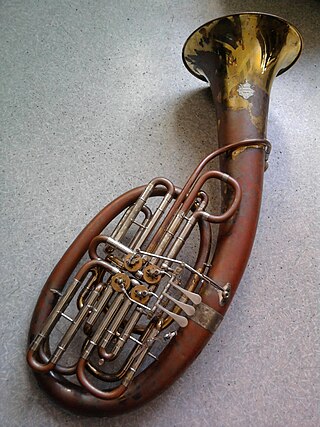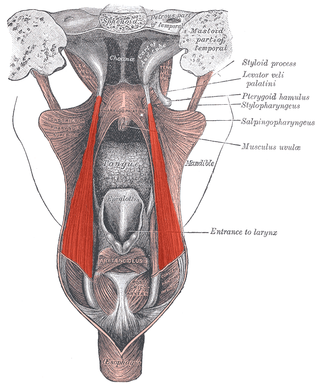Related Research Articles

A brass instrument is a musical instrument that produces sound by sympathetic vibration of air in a tubular resonator in sympathy with the vibration of the player's lips. Brass instruments are also called labrosones or labrophones, from Latin and Greek elements meaning 'lip' and 'sound'.

The tuba is the lowest-pitched musical instrument in the brass family. As with all brass instruments, the sound is produced by lip vibration – a buzz – into a mouthpiece. It first appeared in the mid-19th century, making it one of the newer instruments in the modern orchestra and concert band. The tuba largely replaced the ophicleide. Tuba is Latin for "trumpet".

Origami is the Japanese art of paper folding. In modern usage, the word "origami" is often used as an inclusive term for all folding practices, regardless of their culture of origin. The goal is to transform a flat square sheet of paper into a finished sculpture through folding and sculpting techniques. Modern origami practitioners generally discourage the use of cuts, glue, or markings on the paper. Origami folders often use the Japanese word kirigami to refer to designs which use cuts.

The Wagner tuba is a four-valve brass instrument commissioned by and named after Richard Wagner. It combines technical features of both standard tubas and French horns, though despite its name, the Wagner tuba is more similar to the latter, and usually played by horn players. Wagner commissioned the instrument for his four-part opera cycle Der Ring des Nibelungen, where its purpose was to bridge the acoustical and textural gap between the French horn and trombone.
Bass or Basses may refer to:

A piston valve is a device used to control the motion of a fluid along a tube or pipe by means of the linear motion of a piston within a chamber or cylinder.

The cimbasso is a low brass instrument that covers the same range as a tuba or contrabass trombone. First appearing in Italy in the early 19th century as an upright serpent, the term cimbasso came to denote several instruments that could play the lowest brass part in 19th century Italian opera orchestras. The modern cimbasso design, first appearing as the trombone basso Verdi in the 1880s, has four to six rotary valves, a forward-facing bell, and a predominantly cylindrical bore. These features lend its sound to the bass of the trombone family rather than the tuba, and its valves allow for more agility than a contrabass trombone. Like the modern contrabass trombone, it is most often pitched in F, although models are occasionally made in E♭ and low C or B♭.
A title track is a song that has the same name as the album or film in which it appears. In the Korean music industry, the term is used to describe a promoted song on an album, akin to a single, regardless of the song's title.

The salpingopharyngeus muscle is a muscle of the pharynx. It arises from the lower part of the cartilage of the Eustachian tube, and inserts into the palatopharyngeus muscle by blending with its posterior fasciculus. It is innervated by vagus nerve via the pharyngeal plexus. It raises the pharynx and larynx during deglutition (swallowing) and laterally draws the pharyngeal walls up. It opens the pharyngeal orifice of the Eustachian tube during swallowing to allow for the equalization of pressure between it and the pharynx.

A salpinx was a trumpet-like instrument of the ancient Greeks.

The mesosalpinx is part of the lining of the abdominal cavity in higher vertebrates, specifically the portion of the broad ligament that stretches from the ovary to the level of the fallopian tube.

The transverse folds of rectum are semi-lunar transverse folds of the rectal wall that protrude into the rectum, not the anal canal as that lies below the rectum. Their use seems to be to support the weight of fecal matter, and prevent its urging toward the anus, which would produce a strong urge to defecate. Although the term rectum means straight, these transverse folds overlap each other during the empty state of the intestine to such an extent that, as Houston remarked, they require considerable maneuvering to conduct an instrument along the canal, as often occurs in sigmoidoscopy and colonoscopy.
The chromatic trumpet of Western tradition is a fairly recent invention, but primitive trumpets of one form or another have been in existence for millennia; some of the predecessors of the modern instrument are now known to date back to the Neolithic era. The earliest of these primordial trumpets were adapted from animal horns and sea shells, and were common throughout Europe, Africa, India and, to a lesser extent, the Middle East. Primitive trumpets eventually found their way to most parts of the globe, though even today indigenous varieties are quite rare in the Americas, the Far East and South-East Asia. Some species of primitive trumpets can still be found in remote places, where they have remained largely untouched by the passage of time.
"Tubby the Tuba" is a 1945 song with lyrics written by Paul Tripp and music composed by George Kleinsinger. The original 1946 recording featured Victor Jory's narration. A second recording, released on the Decca label in 1947, was spoken and sung by Danny Kaye and later featured on his Hans Christian Andersen album, along with the sequel, Tubby the Tuba at the Circus.

The pharynx is the part of the throat behind the mouth and nasal cavity, and above the esophagus and trachea. It is found in vertebrates and invertebrates, though its structure varies across species. The pharynx carries food to the esophagus and air to the larynx. The flap of cartilage called the epiglottis stops food from entering the larynx.

Melo melo, common name the Indian volute or bailer shell, is a very large edible sea snail, a marine gastropod mollusc in the family Volutidae, the volutes.

The fallopian tubes, also known as uterine tubes, oviducts or salpinges, are paired tubes in the human female that stretch from the uterus to the ovaries. The fallopian tubes are part of the female reproductive system. In other mammals they are only called oviducts.

Clickbait is a text or a thumbnail link that is designed to attract attention and to entice users to follow that link and read, view, or listen to the linked piece of online content, being typically deceptive, sensationalized, or otherwise misleading. A "teaser" aims to exploit the "curiosity gap", providing just enough information to make readers of news websites curious, but not enough to satisfy their curiosity without clicking through to the linked content. Clickbait headlines often add an element of dishonesty, using enticements that do not accurately reflect the content being delivered. The "-bait" suffix makes an analogy with fishing, where a hook is disguised by an enticement (bait), presenting the impression to the fish that it is a desirable thing to swallow.

Nipa palm vinegar, also known as sukang sasâ or sukang nipa, is a traditional Filipino vinegar made from the sap of the nipa palm. It is one of the four main types of vinegars in the Philippines, along with coconut vinegar, cane vinegar, and kaong palm vinegar. It is usually sold under the generic label of "palm vinegar".

Nafir, also nfīr, plural anfār, Turkish nefir, is a slender shrill-sounding straight natural trumpet with a cylindrical tube and a conical metal bell, producing one or two notes. It was used as a military signaling instrument and as a ceremonial instrument in countries shaped by Islamic culture in North Africa, the Middle East and South Asia. In Ottoman, Persian and Mugulin miniatures, the nafīr is depicted in battle scenes.
References
- ↑ " Salpinx " at Dorland's Medical Dictionary